Exploring the Dynamics of Wing Surf Boards
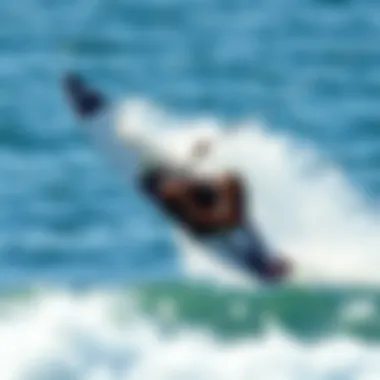
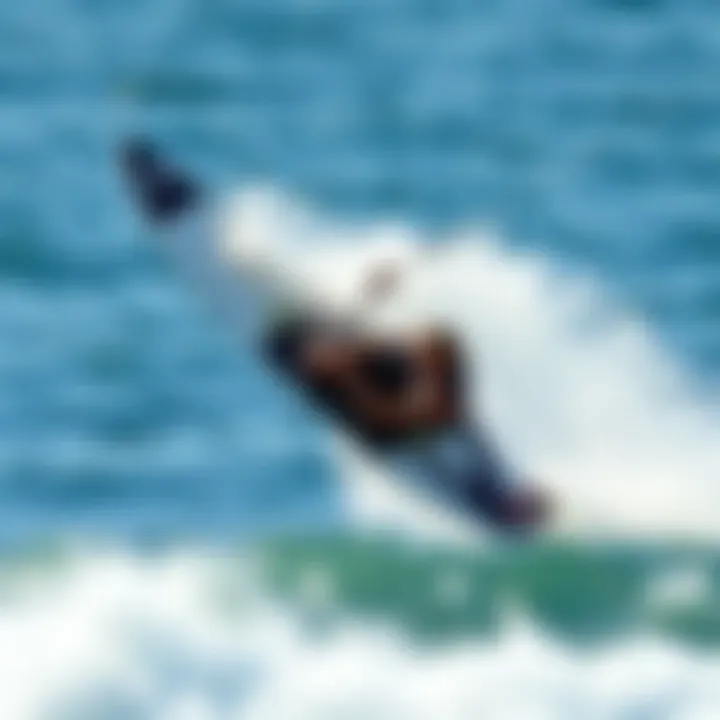
Intro
Wing surfboarding represents an exciting convergence of surfing, kiteboarding, and windsurfing, emerging as a compelling choice for those who crave adventure on the water. The blend of these disciplines has spawned a unique sport that appreciates the sheer joy of harnessing the wind while gliding across the surface of lakes, oceans, or any sizeable body of water. This article will provide a deep dive into the multifaceted world of wing surf boards, dissecting their structure, functionality, and the sheer thrill they bring.
As you dip your toe into this new realm of water sports, you may find the very concept of wing surf boards not just intriguing, but downright transformative. With a design that sets it apart from traditional surfing, wing surf boards are geared towards optimizing riding performance while allowing riders the liberty to maneuver with unparalleled ease. Let's break down the various components that contribute to the exhilaration of wing surfing, including essential gear, varied techniques, and hints to navigate this vibrant world seamlessly.
Gear and Equipment
Essential Gear for Wing Surfing Newbies
Starting with the core of this sport, let's discuss the fundamental equipment needed to enjoy wing surfboarding. The main components that a beginner should look into include:
- Wing: This is the heart of the setup. Wings vary in size, with larger wings offering better pull in low wind conditions.
- Board: A wider board is often more stable for newcomers, allowing for better balance while learning to ride.
- Foil: Adding a foil to the board allows riders to lift above the water's surface, offering a new perspective and feel of riding.
- Safety Gear: A life vest, helmet, and impact shorts are crucial for ensuring safety while riding.
Advanced Equipment for Experienced Riders
Once you've gained some experience and are ready to elevate your game, there are advanced components to consider:
- High Aspect Ratio Wings: These wings provide improved performance for experienced riders, allowing for faster and more agile maneuvers.
- Carving Boards: Svelte and sleek, these boards are designed for cutting through the water with precision while maintaining speed.
- Custom Foils: Tailored foils can significantly enhance performance specific to the conditions and riding style.
Techniques and Tips
Basic Riding Techniques for Newbies
Getting started with wing surfboarding isn't rocket science, but it does have its nuances. Here are a few foundational techniques:
- Getting Started: Begin on calmer waters with steady wind. Position the wing above your head, and as you gain wind, lean into the board, balancing your weight appropriately.
- Maneuvering: Learn to shift your weight from back to front as you gain speed, which will help in controlling the direction of your ride.
- Stopping: To halt your forward motion, pivot the wing back and lean backwards into the wind.
Expert Tricks to Elevate Your Skills
Once you've ridden the waves a bit and are feeling more confident, here are some tricks to add a spark to your performance:
- Tack and Jibe: These maneuvering techniques allow you to change direction smoothly without losing speed.
- Jumping: With practice, you can learn to launch off the water for a thrilling experience. Start with small hops before trying advanced techniques.
- Transitions: Practice switching from heel to toe-side while maintaining balance for added style and flair.
"Wing surfboarding is not just about skill; it’s about feeling free. You learn to dance with the wind and water—and that’s where the magic happens."
In summary, wing surfboarding opens a door to a unique blend of tradition and innovation within the water sports community. By equipping yourself with the right gear and honing your techniques, you set out for an enriching experience that promises adventure and an exhilarating rush. In the upcoming sections, we will explore in greater detail the design intricacies, performance comparisons with kiteboarding and traditional surfing, and much more about this thrilling ride on water.
Prolusion to Wing Surf Boards
Wing surf boards represent a remarkable innovation in the water sports realm, captivating enthusiasts with their unique combination of freedom and performance. Unlike traditional surfboards or kiteboards, wing surfing offers a different experience where the rider uses a wing to harness the wind while standing on a specially designed board. This blending of elements makes understanding wing surf boards not just relevant but essential for anyone looking to dive into this thrilling sport.
The significance of understanding wing surf boards lies in their versatile nature, catering to both beginners and seasoned riders. For novices, grasping the basic principles behind these boards can greatly enhance their learning curve, allowing them to gain confidence faster. On the other hand, advanced users can explore the nuances that distinguish various designs, helping them select the right board for their skill level and riding style.
Wing surfing also opens doors to a wider range of conditions and locations. Being able to ride on flat water, waves, or even in tricky conditions can be the difference between having an exhilarating experience or a frustrating one. Therefore, educating oneself on the characteristics of wing surf boards, from materials to performance features, plays a crucial role in maximizing enjoyment and performance on the water.
Let's embark on a journey to uncover the origins and evolution of these fascinating boards, transitioning seamlessly into the conceptual mechanics that make wing surfing a distinctive experience.
Design Elements of Wing Surf Boards
The design elements of wing surf boards play a pivotal role in determining not just their performance but also the overall experience of the rider. Understanding these elements is essential for anyone looking to enhance their skills, whether you’re a seasoned kiteboarder or just dipping your toes into the thrilling new realm of wing surfing. These boards are crafted with a focus on various aspects that directly influence speed, maneuverability, and stability—factors that can drastically change your surfing experience.
Materials Used
The composition of a wing surf board is one of the most critical factors in its performance. Typically, these boards are made from a variety of materials, each chosen for its unique properties and benefits. For instance, epoxy resin is commonly used due to its lightweight yet durable nature. This offers riders the advantage of less drag in the water.
Additionally, fiberglass is often incorporated for added strength and flexibility. Foam cores are prevalent, too; materials like expanded polystyrene (EPS) or extruded polystyrene (XPS) are favored. They provide buoyancy and keep the board afloat without weighing it down.
Choosing the right materials can help riders in a number of ways:
- Weight Reduction: Lighter boards allow for easier handling and improved speed.
- Durability: High-quality construction can resist the wear and tear that comes from crashing and heavy use.
- Performance Optimization: Different material combinations can adjust stiffness and flexibility, contributing to overall ride quality.
Ultimately, it’s the blend of these materials that can either uplift or collapse a rider's experience.
Shape and Size Considerations
As they say, shape matters. The shape and size of a wing surf board significantly influence how it handles waves and wind. Generally, the design is tailored for specific styles of riding, which dictates the board’s dimensions.
Most boards fall within the range of 5 to 8 feet in length and 20 to 30 inches in width. A wider board provides better stability, balancing those gusty winds while offering easier control, especially for less experienced riders. Meanwhile, a narrower board can slice through the water more efficiently, boosting speed for advanced techniques.
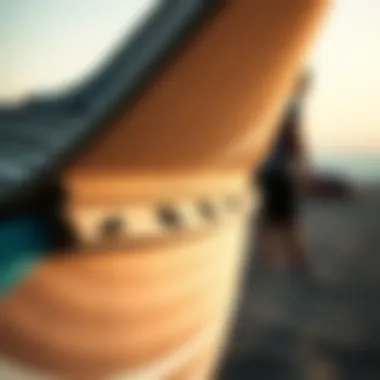

When considering shape:
- Outline: Certain shapes enhance maneuverability; for instance, a rounded outline promotes responsive turns.
- Rockers: Boards designed with a pronounced rocker (the curve of the board) help in wave riding and prevent nose-diving.
- Volume: Thicker boards offer better buoyancy, making it easier to get on the water.
Ultimately, selecting the right shape can mean the difference between a smooth sail across the surface and a frustrating struggle.
Fins and Performance
Fins may appear to be mere accessories, yet they are essential for unlocking the true performance potential of your wing board. They act as a stabilizing mechanism, aiding in steering and control during rides. Typically, wing surf boards come equipped with either thruster or quad fin setups, each with its benefits.
- Thruster Setup: This traditional three-fin configuration offers great maneuverability and control, making it an ideal choice for riders who prioritize sharp turns and quick responses.
- Quad Setup: With four fins, this arrangement can provide more speed and stability, particularly useful in choppy conditions or while jumping.
When selecting fins, consider the following:
- Size: Larger fins can offer more grip, while smaller fins can enhance speed.
- Material: Carbon or fiberglass fins can be lighter and more durable.
- Flexibility: Different flex patterns can influence the ride by affecting how the board interacts with the water.
"Choosing the right design elements can make your wing surfing experience not just about riding the waves, but mastering them."
Wing Surf Board Performance Analysis
The performance of wing surf boards plays a pivotal role in determining how effectively riders can engage with the water and the wind. Understanding elements like speed, maneuverability, stability, and control allows enthusiasts to choose the right gear and techniques to enhance their experience on the water. It's not merely about catching waves or feeling the wind; it’s about combining skill with the right equipment to navigate diverse conditions. Whether you're a novice or a seasoned rider, diving into the dynamics of performance can elevate your enjoyment of this exhilarating sport.
Speed and Maneuverability
Speed and maneuverability are the bread and butter of wing surfing. The thrill of gliding swiftly across the water, harnessing the wind's power, is undeniable. Wing surf boards are designed to be lightweight, allowing for acceleration that makes them feel almost buoyant on the surface.
- Lightweight Construction: Materials such as carbon fiber or advanced composites help keep the weight down while adding strength. This makes it simpler to reach faster speeds without much effort.
- Foil Design: The design of the foil significantly impacts both speed and maneuverability. A well-engineered foil not only cuts through the water effectively but also allows riders to carve through turns, giving them the freedom to navigate tricky spots or glide in open waters.
- Wind Conditions: For optimal performance, understanding the wind conditions is crucial. A board that excels in light wind may not perform as well in high wind scenarios, and vice versa.
"The beauty of wing surfing lies not just in the speed, but in the way it connects a rider with the elements; a perfect blend of power and agility."
Stability and Control
Stability and control can mean the difference between a smooth ride and a frustrating experience. These two elements dictate how confidently a rider can maneuver across various water conditions, from calm seas to choppy waves.
- Board Width: A wider board usually provides greater stability, which is advantageous for beginners learning to balance. On these boards, even a slight shift in weight does not result in dramatic dips or flips.
- Foil Size and Shape: Just as crucial is the foil's size–a larger foil might offer better lift in light winds, but can become cumbersome as the wind picks up. Finding the perfect balance is where rider skill comes in.
- Rider Position: How a rider positions themselves also plays a significant role in controlling the board’s behavior. Shifting weight to the back or front can adjust speed and alter the board's glide angle.
Comparative Performance: Wing Surf Boards vs. Kiteboards
When drawing comparisons between wing surf boards and kiteboards, it's essential to recognize the strengths and weaknesses of each.
- Ease of Use: Wing boards typically provide a more intuitive learning curve than kiteboards. Beginners often find they can start wing surfing with fewer lessons due to the ease of controlling the wing attached.
- Wind Dependency: Kiteboards usually require stronger winds to perform optimally, while wing boards can often perform reasonably well with lighter winds, making them more accessible for those in varying wind conditions.
- Mobility & Setup: Wing surf boards offer improved mobility. Unlike kiteboards that require a more complex setup process, wing boards can often be more straightforward in getting out on the water quickly.
In summary, as one navigates through the performance analysis of wing surf boards, it becomes clear that a deep understanding of speed, maneuverability, stability, control, and how they stack up against kiteboards, can significantly enhance the experience for enthusiasts. Whether speeding across a serene lake or mastering the waves at the beach, performance intricacies hold keys to unlocking the full potential of wing surfing.
Tech Innovations in Wing Surfing
In the ever-evolving world of wing surfing, technology plays a pivotal role in enhancing performance and safety. The latest innovations not only make the sport more accessible to newcomers but also provide seasoned riders with tools to push their limits further. As we dive into this topic, it becomes clear that understanding the technological advancements made in wing surfing is key to appreciating the sport's current landscape and future potential.
Advancements in Wing Technology
Recent developments in wing technology have transformed how riders interact with wind and water. Today's wings are lighter, stronger, and more efficient than ever before. For instance, materials like ripstop nylon and mylar are often chosen for their durability and reduced weight, allowing for greater lift and maneuverability.
Some notable advancements include:
- Inflatable Wings: These wings have redefined portability and ease of setup, making them ideal for recreational and competitive use. Riders can easily inflate and pack their gear, allowing for spontaneous trips to the water.
- Design Optimization: Innovations in design have led to improved aerodynamics. Wings are now crafted with specific sail shapes that maximize lift while minimizing drag. This means riders can achieve greater speeds with less effort.
- Adjustable Straps and Handles: Modern wings often come equipped with adjustable straps and handles, allowing riders to customize their grip based on personal comfort and riding style.
Through these advancements, wing technology not only enhances the experience for riders but also fosters a more inviting atmosphere for those just starting out.
Impact of AI and Sensor Technology
Artificial intelligence and sensor technology are making waves in wing surfing, significantly shifting how riders approach the sport. Smart gear equipped with sensors can provide real-time feedback on various metrics such as speed, wind direction, and even body posture. This data helps riders make informed decisions on the water, improving their skills faster than traditional methods alone could allow.
Key impacts of AI and sensor technology in wing surfing include:
- Performance Tracking: Devices now offer comprehensive analyses of a rider's performance, allowing them to pinpoint areas for improvement. By understanding their speed and glide efficiencies, riders can adjust their techniques accordingly.
- Weather Forecasting: Advanced AI systems now synthesize data from various weather sources, thus offering real-time updates on changing conditions. This ensures riders have the best information to choose ideal times and locations to hit the water.
- Safety Enhancements: Some wings are coming equipped with sensors that alert riders to crucial changes in wind patterns, which can be invaluable in preventing accidents. Riders can focus on their enjoyment without constantly looking over their shoulders.
"With technology guiding us, the thrill of wing surfing is no longer just about mastering the waves; it's about harnessing the power of innovation to enhance our experience on the water."
Essential Gear for Wing Surfing
Wing surfing opens a whole new world of thrills on the water, but just like any adventure sport, having the right gear can make or break your experience. Whether you're just starting or have some miles under your belt, the right equipment pays dividends in performance and safety, ensuring you can enjoy the wind and waves with confidence.
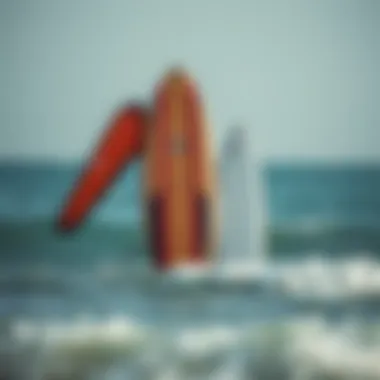
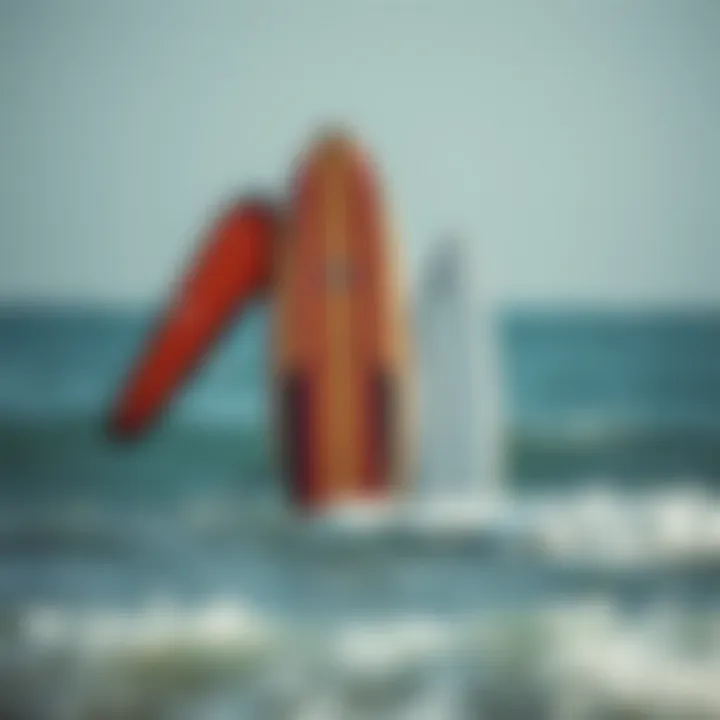
Choosing the Right Wing Board
Choosing the right wing board isn't a one-size-fits-all scenario. Different boards cater to various styles, conditions, and skill levels. Considerations include size, shape, and volume. As a rule of thumb, beginners usually benefit from a larger board—it's more stable and easier to balance. On the contrary, seasoned riders might prefer a smaller board for enhanced maneuverability and speed.
- Size Matters: A bigger board provides more surface area, making it easier to get up on the foil and stay up, while smaller boards lend themselves to tricks and dynamic riding.
- Shape: Entering the world of aerodynamics, the nose shape impacts how the board handles chop and wind. Pointed noses cut through waves, while rounder profiles tend to be more forgiving and easier for beginners.
- Volume: Volume dictates buoyancy. More volume means easier floatation. A good rule of thumb: match the board's volume with your weight. If you're hovering around 85 kg, look for boards in the 120 liters range to start.
Each rider’s needs are unique, so it’s advisable to test out various boards if possible before making a purchase. You can often find demo days at local spots or shops—take advantage of that.
Safety Equipment and Accessories
When it comes to wing surfing, safety gear isn’t just a precaution; it’s a necessity. While the thrill is undoubtedly captivating, the unpredictability of water and wind demands that we prioritize safety.
First up is a personal flotation device (PFD). You really want to have this handy even if you consider yourself a strong swimmer. There are many streamlined options available today that won’t hinder your mobility.
Other essentials include:
- Helmet: Trust me, a hard head will save you from potential injury. Unexpected falls can lead to head injuries, and a helmet mitigates that risk.
- Impact Vests: These are great for cushioning the blows, especially in rough water or if you’re learning new tricks.
- Wetsuit or Drysuit: Depending on the climate, this will not only keep you warm but also provide a layer of protection against abrasions.
- Leash: A leash that attaches to your wing can prevent it from blowing away in case of a fall.
"Safety first, fun second! Equip yourself well to enjoy every moment on the board."
It’s also a smart idea to carry a basic first aid kit. Small cuts and scrapes can happen, and being prepared can make a world of difference in enjoying your time out.
With thoughtful choices in your gear, you will experience the essence of wing surfing more fully while keeping the fun levels sky-high. Dive into this exhilarating sport while safeguarding your adventures, and enjoy every gust of wind!
Techniques for Mastering Wing Surfing
Mastering wing surfing requires not just an understanding of the gear but also the specific techniques that will enable riders to navigate the water with skill and confidence. Being proficient in wing surfing can enhance the overall experience greatly—from catching the wind just right to executing sharp turns with flair. It's essential for riders of all levels to focus on both foundational skills and the advanced maneuvers that can elevate their performance.
"Success in wing surfing isn’t just about strength; it’s about harnessing the wind and water in harmony; technique is the bridge connecting the two."
Basic Techniques for Beginners
For those just dipping their toes in the water, several fundamental skills serve as the building blocks for successful wing surfing. Gaining comfort with these basics is akin to learning to ride a bike; once you grasp it, you glide with ease.
- Stance and Balance: The first step is to establish a solid stance. Feet should be shoulder-width apart, knees slightly bent, and a low center of gravity ensures balance. Beginners might feel a bit wobbly at first, but finding the right position will drastically improve stability.
- Getting Up and Going: Once the wing is inflated, learning how to lift off is crucial. Beginners can start by lying on the board, then pushing up with their hands while keeping the wing positioned above them to catch the wind. This initial push can feel daunting, but practice will make it second nature.
- Controlling the Wing: Harnessing the wing’s power takes practice. Beginners should concentrate on directing the wing in front while ensuring it's tilted slightly backward to maintain lift. Pulling on the handles firmly but gently will lead the rider forward while keeping them from getting overtaken by the wind.
- Turning: Learning to turn involves practicing shifts in weight and reorienting the wing. Riders should lean into the turn, shifting their weight onto their toes while adjusting the wing accordingly.
These steps may seem reactive, but mastery comes with experience and time on the water. Finding a local group or a buddy to practice with can also provide valuable insight and support.
Advanced Riding Techniques
Once a wing surfer has grasped the basics, it’s time to tackle more advanced techniques. These skills not only refine performance but also add an exciting element to the experience.
- Jumping and Freestyle Moves: For the more adventurous, learning to jump can add a thrilling aspect to wing surfing. Approaching at speed, riders should crouch low, then push off the water using their legs while pulling up on the wing. Timing and technique are everything here—those who get it right often find themselves soaring.
- Tacking and Jibing: Mastering tacks and jibes allows a rider to change direction without losing momentum. A tack involves turning upwind, while a jibe is downwind. Both require agility and well-timed shifts in weight along with wing position adjustments.
- Reading the Wind: Experienced riders can gauge wind patterns and adjust their riding style accordingly. Understanding how the wind interacts with the water can help manage speed and direction more effectively.
- Being Aware of Surroundings: Advanced surfers need to master the art of awareness. Recognizing other surfers, changes in water conditions, and potential hazards will not only keep you safe but also enhance the overall experience.
Improving these advanced techniques takes time and practice, but with dedication and patience, surfers will find new heights—both literally and figuratively—in their wing surfing journey.
The blend of diverse techniques in wing surfing not only improves control and efficiency but also fosters a deeper appreciation for the sport. In many ways, it is akin to dance—a beautiful exchange between nature and the rider.
Safety Considerations in Wing Surfing
When it comes to wing surfing, safety isn’t just a box to tick off; it’s the linchpin that holds together exhilarating rides and your well-being. Knowing how to navigate the waters safely can turn a frightening experience into a thrilling one. This segment delves into the safety considerations that are paramount for both novices and seasoned riders.
Risk Assessment and Management
Risk assessment might sound like a complicated term tossed around in board rooms, yet it’s quite straightforward when you break it down. As a rider, it’s crucial to evaluate the conditions before setting sail.
- Weather Considerations: The wind speed and direction play a massive role in your ride. Favorable winds can enhance performance, whereas unpredictable gusts can catch you off guard. One useful tip: always check local wind forecasts, and try to gauge conditions over a nearby shoreline before heading out.
- Environmental Factors: Pay attention to your surroundings. Identify rocks, shallow areas, or other potential hazards in the water before you start. A single misjudgment could result in an unfortunate crash.
- Your Skill Level: This cannot be overstated. If you’re still finding your balance, consider starting in calm waters. Advanced riders, on the other hand, may appreciate the challenge posed by rougher conditions—but stay within your limits.
By effectively managing these risks, you can not only enjoy better rides but also foster safe habits that could save lives.
"Safety isn’t a gadget but a state of mind."
Common Injuries and Prevention
Despite the thrill that wing surfing delivers, certain injuries are unfortunately part and parcel of the sport. However, understanding common injuries can enable you to take precautions to steer clear of them.
- Wrist Injuries: Falling is part of the learning curve, especially when you’re just starting out. Wrist injuries often occur during beginner falls. Wearing well-fitted wrist guards can minimize this danger.
- Shoulder Dislocations: These can result from uncontrolled wipeouts. Proper warm-up exercises beforehand, along with learning how to fall correctly, can significantly reduce the likelihood of this injury.
- Cuts and Scrapes: Sharp debris or marine life can expose you to minor injuries. Always inspect your equipment for damage and consider wearing a wetsuit for added protection.
To keep risks at bay, it’s smart to engage in regular training on both riding techniques and safety practices.
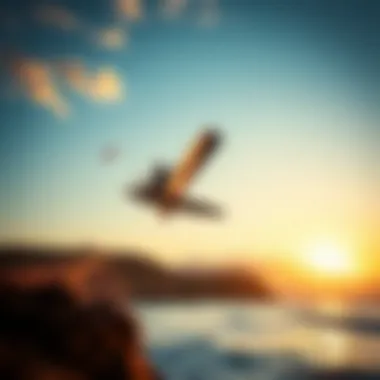
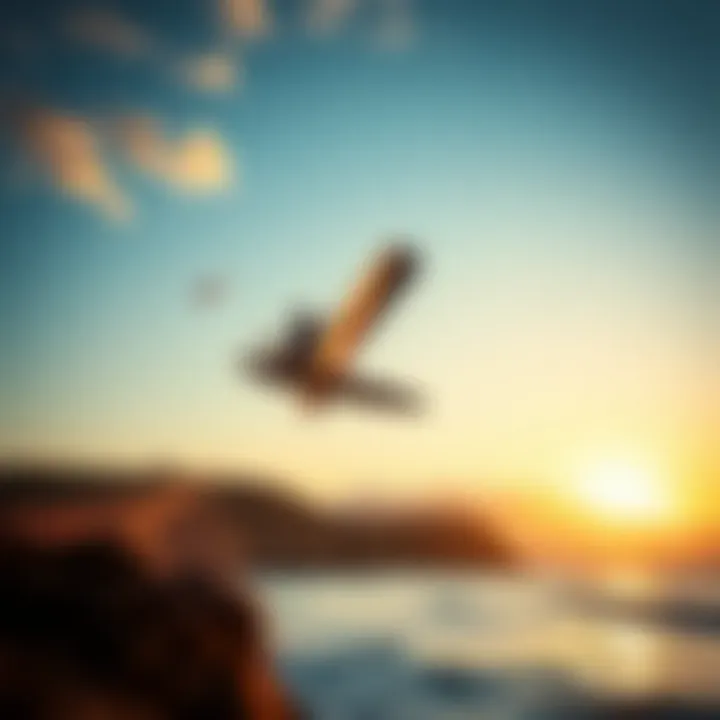
- Consider these additional preventive measures:
- Attend workshops or lessons to enhance your skills.
- Invest in quality safety gear, such as helmets and impact vests.
Overall, the journey in wing surfing should be as safe as it is thrilling. Taking these considerations to heart could pave the way for memorable adventures on the water.
Maintenance and Care for Wing Surf Boards
Taking care of wing surf boards is like caring for a delicate instrument; it ensures their performance and longevity. Just like a finely tuned guitar demands regular string changes and maintenance, wing surf boards benefit significantly from proper care and attention. A well-maintained board not only enhances the rider’s experience but can also save money in the long run by avoiding costly repairs or replacements. Emphasizing routine maintenance and safe storage practices can keep a board in top shape, prolonging its lifespan and ensuring peak performance on the water.
Routine Maintenance Practices
Routine maintenance isn’t just a suggestion; it’s a necessity to keep your wing surf board performing at its best. Here are several practices that should become a part of your regular care routine:
- Cleaning: After each session, make sure to rinse your board with fresh water, especially if you’ve been out in saltwater. This simple step helps to remove any sand, salt, or debris that could affect performance over time.
- Inspections: Regularly check for any signs of wear and tear, such as dings or scratches. Even small damages can exacerbate over time, leading to significant issues. Catching these early allows for timely repairs.
- Wings and Foils: Ensure that the wings and foils are also maintained. Look for any integrity issues, check screws and fastenings, and ensure that the connections are clean and free from debris.
- Pressure Testing: If your board has inflatable components, regularly pressure test them to ensure they are adequately inflated. An underinflated wing can affect lift and stability.
- Storage Cleaning: Before storing your board for a long period, conduct a thorough clean to prevent any mold or mildew buildup.
Maintaining these practices consistently ensures that your wing surf board stays responsive and handles beautifully, letting you slice through the water with grace.
Storage and Transport Considerations
The way you store and transport your wing surf board can have a significant impact on its durability. Here are essential tips for doing it right:
- Dry Storage: Always store your board in a dry, shaded area. Prolonged exposure to sunlight can degrade materials, especially foam and plastics. A deck bag can provide UV protection when transporting or storing.
- Avoiding Pressure Points: When stacking boards or transporting them, avoid placing heavy items on top that might cause pressure points. Invest in padded bags to eliminate the risk of dings or pressure marks.
- Temperature Control: Extreme temperatures can be detrimental. Ensure your board is not stored in areas subject to severe heat or cold, such as directly inside a vehicle under the sun. This can warp or deteriorate materials over time.
- Transporting with Care: Use a soft or padded bag during transportation. This provides a buffer against impacts that may occur during transit. Secure the board properly with straps to prevent shifting.
Remember, your wing surf board is more than just equipment; it’s an investment in your adventure. With proper care and storage, it not only performs better but can also give you countless thrilling rides for years to come.
In summary, regular maintenance and smart storage practices are integral to preserving the integrity and performance of wing surf boards. By embedding these habits into your routine, you ensure an optimal wing surfing experience and safeguard your investment.
Global Destinations for Wing Surfing
The realm of wing surfing has gained traction in recent years, and with that growth comes a multitude of opportunities to explore unique spots around the globe. These destinations hold tremendous significance for both seasoned enthusiasts and those just embarking on their wing surfing journey. The right location not only influences the overall experience, but also plays a pivotal role in skill development, safety, and enjoyment.
As with many outdoor sports, a surfer’s location can challenge or enhance the overall experience. Factors like wind consistency, wave size, and local conditions can interplay to create an environment conducive to learning or pushing one’s limits. Additionally, a picturesque background amid nature is often the cherry on top that makes each session more fulfilling.
In this section, we’ll delve into two categories of destinations: those perfect for beginners and the more challenging locales that seasoned riders might seek. Both types cater to unique needs and will help demonstrate the breadth of the wing surfing community.
Top Spots for Beginners
- La Ventana, Mexico
La Ventana is a haven located on the Baja Peninsula. Its steady winds and relatively flat water make it an ideal training ground for new riders. The local instructors are quite knowledgeable and often conduct clinics, ensuring that novices receive personalized attention. - Hatteras Island, North Carolina
Known for its lush landscapes and kite surfing history, Hatteras provides ample opportunities for beginners. The shallow waters create a safe space for practice, while the community of surfers and instructors is welcoming and eager to share their passion for the sport. - Cabarete, Dominican Republic
This tropical paradise is not only a place of beauty, but also an excellent locale for those new to wing surfing. The warm weather year-round offers plenty of practice days, while the local schools provide rentals and lessons to assist newcomers. - Maui, Hawaii
Maui's beaches, especially along the North Shore, offer a plethora of conditions for beginners. The Blue skies and consistent trade winds make for enjoyable sessions, while the local culture fosters a supportive atmosphere.
Each of these locations offers defined advantages for beginners. Emphasis on safety, instruction, and community can make the transition into wing surfing enjoyable. A warm welcome can transform any apprehension into excitement.
Challenging Destinations for Experts
- Fuerteventura, Canary Islands
Known for its strong winds and powerful waves, Fuerteventura is a hotspot for advanced riders seeking adrenaline. The varying conditions challenge the most skilled surfers to refine their techniques and hone their skills. Be forewarned; this spot requires respect for the water and respect for fellow surfers navigating the same waves. - Lefkada, Greece
Lefkada has garnered attention for its windsurfing terrains that offer thrilling challenges. Expert wing surfers can navigate its various spots, where waves and wind combine to present an exhilarating experience. The stunning coastal views serve as a backdrop to the sheer thrill of high-speed rides. - Cape Town, South Africa
With its diverse landscapes and intense winds, Cape Town’s waters become a playground for seasoned riders. The famous "Cape Doctor" winds create a dynamic environment, suitable for those wanting to test their skills against challenging conditions. The allure of Table Mountain nearby adds to the heart-pounding excitement. - Margaret River, Australia
This destination is not for the faint of heart. Known for its powerful swell and unpredictable winds, Margaret River attracts elite riders looking to push their limits. Local conditions can change in a heartbeat, demanding quick reactions and solid skills.
Challenging destinations like these provide intense learning opportunities, pushing experts to break barriers in their skillset. Assuredly, the thrill of riding amongst waves and challenging winds solidifies the bonds within the sport and its community.
As the wing surfing trend gains momentum, destinations are evolving, and soon every corner of the world may be welcoming wing surfers to its waters.
In summary, choosing the right destination is vital for enhancing one’s skills in wing surfing. Whether embarking on a new adventure as a beginner or seeking to conquer the waves as an expert, knowing where to go can make all the difference in the world. For further exploration of wing surfing locations, resources such as Wikipedia and Reddit can provide invaluable insights.
The Future of Wing Surfing
In the world of water sports, wing surfing has emerged not just as a passing trend, but as a significant player that reshapes how enthusiasts approach the waves. Its future hinges on several factors, including technological advancements, growing community engagement, and evolving cultural perceptions. This discussion not only aims to highlight the importance of these elements but also underscores the broader implications of wing surfboards in outdoor sports.
The growing interest in wing surfing is palpable, with individuals from varying backgrounds—whether seasoned kiteboarders or newcomers drawn to water sports—finding their footing on a wing board. With its unique blend of stability and speed, wing surfing promises a more accessible experience while maintaining the thrill of traditional water sports. As more people are drawn to this horizon-expanding sport, there's a burgeoning potential for community building and cultural impact.
Emerging Trends and Predictions
The next phase of wing surfing is ripe with opportunities, driven by innovation and creativity. Some trends on the horizon include:
- Technological Integration: Advanced materials and designs are steadily hitting the market. For instance, boards that utilize lighter, more durable composites offer improved performance and user-friendliness.
- Smart Equipment: Imagine boards equipped with sensors that provide real-time feedback on performance. As technology becomes more integrated, the learning curve for beginners could flatten significantly.
- Sustainability Initiatives: With increasing environmental awareness, manufacturers might start producing eco-friendly gear, paving the way for a sustainable future in wing surf equipment.
These elements signify an exciting era for wing surfing, creating a synergy between performance, enjoyment, and environmental consciousness.
Community and Cultural Impact
The rise of wing surfing has fostered a sense of camaraderie among enthusiasts, uniting them under a shared passion for the sport. This community extends beyond just surfing; it creates a culture that embraces inclusivity. Workshops, social media groups, and meet-ups are blossoming, enabling riders to connect, share advice, and exchange experiences.
Moreover, the cultural ramifications of wing surfing include:
- Expanding Demographics: With its growing popularity, wing surfing attracts a diverse range of participants. New communities form around this sport, each bringing its unique flair and perspective, enhancing the overall experience.
- Content Creation: As adventurers embrace wing surfing, social media platforms become filled with stunning visuals and tutorials. This, in turn, cultivates interest and inspires others to join.
- Global Events: Competitions and exhibitions can level the field for participants. These events not only showcase impressive skills but also allow discussion around techniques and future innovations.
“Wing surfing isn’t just about riding waves; it’s about building a culture that resonates with adventure and community spirit.”
The future of wing surfing promises to be dynamic, leveraging technological advancements, fostering community ties, and bridging cultural gaps within the vast ocean of outdoor sports. This sport embodies more than just the thrill of the ride; it encapsulates a vision for how water sports can evolve in the years to come.















